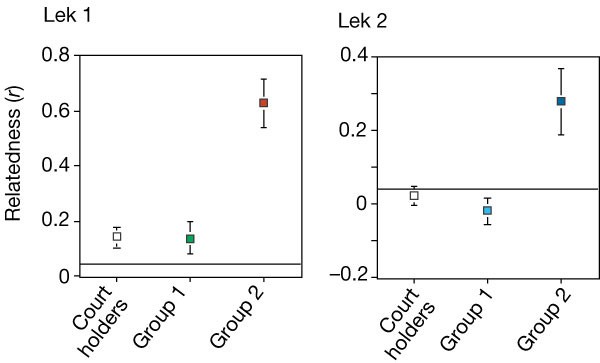
- Select a language for the TTS:
- UK English Female
- UK English Male
- US English Female
- US English Male
- Australian Female
- Australian Male
- Language selected: (auto detect) - EN
Play all audios:
ABSTRACT Leks have traditionally been considered as arenas where males compete to attract females and secure matings. Thus, direct fitness benefits mediated through competition between males
to fertilize females have been considered to be the primary force driving the evolution of lekking behaviour1,2. Inclusive fitness benefits mediated through kin selection3 may also be
involved in lek formation and evolution4,5, but to date this theory has been largely ignored. According to kin-selection theory, both reproducing and non-reproducing males may gain indirect
inclusive fitness benefits. If females are attracted to larger leks, non-reproducing males add attractiveness to a lek, and therefore, in a genetically structured population, boost the
reproductive success of kin. Theory predicts that the attractiveness of leks is plastic, and that males establish themselves on a lek in which the top male, in terms of reproductive success,
is a close relative6. Here we show that in white-bearded manakins (_Manacus manacus_), for which larger leks are more attractive to females7,8 and so secure the maximum number of matings,
there is extraordinary fine-scale genetic structure, with leks being composed of clusters of related kin. We propose that males establish themselves where they find relatives to such an
extent that they form groups within leks, and that such behaviour is consistent with kin-selection theory to maximize reproductive success of the group. Access through your institution Buy
or subscribe This is a preview of subscription content, access via your institution ACCESS OPTIONS Access through your institution Subscribe to this journal Receive 51 print issues and
online access $199.00 per year only $3.90 per issue Learn more Buy this article * Purchase on SpringerLink * Instant access to full article PDF Buy now Prices may be subject to local taxes
which are calculated during checkout ADDITIONAL ACCESS OPTIONS: * Log in * Learn about institutional subscriptions * Read our FAQs * Contact customer support SIMILAR CONTENT BEING VIEWED BY
OTHERS RELATEDNESS-BASED MATE CHOICE AND FEMALE PHILOPATRY: INBREEDING TRENDS OF WOLF PACKS IN A HUMAN-DOMINATED LANDSCAPE Article Open access 12 March 2024 THE ROLE OF KINSHIP AND
DEMOGRAPHY IN SHAPING COOPERATION AMONGST MALE LIONS Article Open access 16 October 2020 SUCCESSFUL BREEDING PREDICTS DIVORCE IN PLOVERS Article Open access 23 September 2020 REFERENCES *
Höglund, J. & Alatalo, R. V. _Leks_ (Princeton Univ. Press, Princeton, 1995). Book Google Scholar * Wiley, R. H. Lekking in birds and mammals: Behavioral and evolutionary issues. _
Adv. Study Behav._ 20, 201–291 (1991). Article Google Scholar * Hamilton, W. D. The genetical evolution of social behaviour I. _J. Theor. Biol. _ 7, 1–16 (1964 ). Article CAS Google
Scholar * Höglund, J., Alatalo, R. V., Lundberg, A., Rintamäki., P. T. & Lindell, J. Microsatellite markers reveal the potential for kin selection on black grouse leks. _ Proc. R. Soc.
Lond. B_ 266, 813–816 (1999). Article Google Scholar * Petrie, M., Krupa, A. & Burke, T. Peacocks lek with relatives even in the absence of social and environmental cues. _Nature_ 401,
155– 157 (1999). Article CAS ADS Google Scholar * Kokko, H. & Lindström, J. Kin selection and the evolution of leks: whose success do young males maximise? _Proc. R. Soc. Lond. B_
263, 919–923 ( 1996). Article ADS Google Scholar * Lill, A. Social organization and space utilization in the lek-forming white-bearded manakin, _ M. manacus trinitatis_ Hartert. _Z.
Tierpsychol._ 36, 513–530 (1974). Article CAS Google Scholar * Kokko, H., Sutherland, W. J., Lindström, J., Reynolds, J. D. & Mackenzie, A. Individual mating success, lek stability,
and the neglected limitations of statistical power. _ Anim. Behav._ 56, 755–762 (1998). Article CAS Google Scholar * Snow, D. W. A field study of the black and white manakin, _Manacus
manacus_, in Trinidad. _Zoologica_ 47, 65–104 (1962). Google Scholar * Lill, A. Sexual behavior of the lek forming white-bearded manakin (_Manacus manacus trinitatis_ Hartert). _Z.
Tierpsychol._ 36, 1–36 (1974). Article CAS Google Scholar * Lynch, M. & Ritland, K. Estimation of pairwise relatedness with molecular markers. _Genetics_ 152, 1753 –1766 (1999). CAS
PubMed PubMed Central Google Scholar * Sherman, P. W. Birds of a feather lek together. _Nature_ 401, 119–120 (1999). Article CAS ADS Google Scholar * Sherman, P. W., Reeve, H. K.
& Pfennig, D. W. in _Behavioural Ecology An Evolutionary Approach_ 4th edn (eds Krebs, J. R. & Davies, N. B.) 69–96 (Blackwell, Oxford, 1997). Google Scholar * McDonald, D. B. &
Potts, W. K. Cooperative display and relatedness among males in a lek-mating bird. _Science_ 266, 1030–1032 (1994). Article CAS ADS Google Scholar Download references ACKNOWLEDGEMENTS
We thank C. Fitzjames, J. Johnston and T. Lievonen for help in the field, S. Griffith for advice and R. Dufva for help in the lab. The study was funded by the Swedish Natural Sciences
Research Council (NFR) (to J.H.). AUTHOR INFORMATION AUTHORS AND AFFILIATIONS * Population Biology/EBC, Uppsala University, Norbyvägen 18D, Uppsala , SE-752 36, Sweden Lisa Shorey &
Jacob Höglund * Department of Zoology, NERC Molecular Genetics in Ecology Initiative, University of Aberdeen, Tillydrone Avenue, Aberdeen, AB24 2TZ, UK Stuart Piertney * Animal Ecology/EBC,
Uppsala University, Norbyvägen 18D, Uppsala, SE-752 36, Sweden Jon Stone Authors * Lisa Shorey View author publications You can also search for this author inPubMed Google Scholar * Stuart
Piertney View author publications You can also search for this author inPubMed Google Scholar * Jon Stone View author publications You can also search for this author inPubMed Google Scholar
* Jacob Höglund View author publications You can also search for this author inPubMed Google Scholar CORRESPONDING AUTHOR Correspondence to Lisa Shorey. SUPPLEMENTARY INFORMATION
SUPPLEMENTARY TABLE: MICROSATELLITE MARKERS USED TO DEFINE RELATEDNESS. (DOC 21 KB) RIGHTS AND PERMISSIONS Reprints and permissions ABOUT THIS ARTICLE CITE THIS ARTICLE Shorey, L., Piertney,
S., Stone, J. _et al._ Fine-scale genetic structuring on _Manacus manacus_ leks. _Nature_ 408, 352–353 (2000). https://doi.org/10.1038/35042562 Download citation * Received: 22 May 2000 *
Accepted: 21 August 2000 * Issue Date: 16 November 2000 * DOI: https://doi.org/10.1038/35042562 SHARE THIS ARTICLE Anyone you share the following link with will be able to read this content:
Get shareable link Sorry, a shareable link is not currently available for this article. Copy to clipboard Provided by the Springer Nature SharedIt content-sharing initiative







